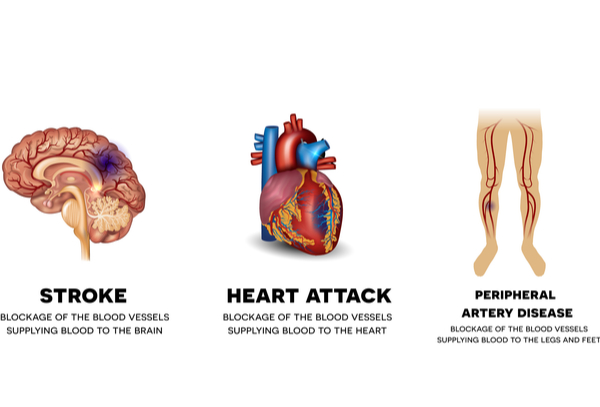Walking may seem easy to do, but it has a long list of health benefits. One health issue we are particularly interested in is PAD, or peripheral artery disease. Find out the ways that walking helps prevent PAD and other vascular problems. Strenuous exercise is not a requirement for vascular health!
What is PAD?
Peripheral vascular disease, or PAD for short, is a circulatory disease where limbs experience reduced blood flow due to restricted blood vessels. Narrowed blood vessels can occur from buildup inside vein walls from fatty deposits and calcium. Fatty deposits are also known as atherosclerosis, and this is the most likely cause of vein restriction.
Vein restriction from atherosclerosis mainly occurs in the legs and sometimes in the arms. When enough blood flow is not available to an area, it causes pain when walking or moving around. Leg pain from PAD while walking is known as claudication.
Symptoms of PAD
Some people experience no symptoms at all with PAD, while for others, PAD causes debilitating pain.
- Painful cramping in hips, thighs, calves after minor activity
- Numbness and weakness in the legs and arms
- One leg or foot being colder
- Sores on the toes, feet, or legs that do not heal
- Skin color changes on limbs
- Slow toenail growth and hair growth on limbs
- Weak to no pulse in limbs
- Erectile dysfunction
If peripheral artery disease is left untreated, it can progress to become dangerous. As more plaque builds up, complications with serious implications occur.

One complication is open sores that don’t heal and become infected. Without proper blood flow, the tissue in the area can die. This type of tissue death from PAD is known as critical limb ischemia. When tissue death occurs, limbs may need amputation to prevent further tissue death and infection throughout the body.
There is another better-known and deadly complication of fat buildup in veins and arteries. Stroke and heart attack can occur from the lack of blood to the brain and heart.
How Walking Reverses Peripheral Artery Disease
Luckily, all these complications are avoidable with a simple exercise. Walking has the effect of preventing and reversing PAD. For most, walking is a low-impact and safe way to elevate heart rate and get the blood moving through the body.
If you already have peripheral artery disease, jumping into a strenuous exercise routine can have dangerous results. With restricted blood flow from arterial plaque, high-impact exercises can require more blood flow than the body can supply. An undersupply of blood to the heart or brain can result in heart failure and stroke.
With regular walking, your circulation will improve as new blood vessels form to provide the body with needed blood. By walking 5 days a week for at least 50 continuous minutes, you can prevent PAD and symptoms will disappear in around 3-6 months.
Sample Walking Workout to Improve and Prevent PAD
- Warm up with calf and thigh stretches for about 15 seconds in each leg.
- Walk at a fast pace for 5 minutes, even if there is mild pain.
- Take a break until the pain goes away.
- Get back to walking after the pain subsides and repeat this walk rest cycle for at least 35 minutes.
- Every week add 5 minutes to the total goal until you reach 50 minutes of walk time.
- Cooldown by walking slowly for 5 minutes and stretching again.
As the weeks go by and you are experiencing less pain, take fewer breaks. Eventually, you should be able to walk for 50 minutes without taking a break. For maintenance, you should walk 50 minutes 3 to 5 times per week.
Other Tips To Manage and Prevent PAD
To manage peripheral artery disease, lifestyle changes are essential. Many factors contribute to vascular health that will relieve the symptoms of PAD. Along with walking, here are some other tips for vascular heath:
- Stop smoking. Nicotine restricts blood vessels.
- Eat healthy food in appropriate portions. Maintaining a healthy weight puts less stress on the vascular system.
- Cut back on sugar, especially if you have diabetes.
- Reduce your salt intake by avoiding processed foods to prevent heart failure.
- Choose healthy fats instead of saturated fat to lower your cholesterol.
- Reduce your stress to keep your blood pressure low.
- Take care of your feet by washing them daily, wearing cotton socks, avoiding temperature extremes, and keeping toenails trimmed. This is to prevent sores and infection.
PAD Screening and Awareness
If you are feeling leg pain with activity, getting to the doctor for a checkup is imperative. Your vascular surgeon will diagnose PAD in a variety of ways.
Pulse Check
One way is to check pulses. Pulses are checked on the top of feet, ankles, behind the knee, and groin.
Skin Check
Skin gives another clue of low blood flow as its health is diminished by not getting enough oxygen. Your doctor will look for signs like cool, thin, or shiny skin. Hair may stop growing and fall out as well.
Blood Test
A blood test will also check your cholesterol, blood sugar, and kidney function for peripheral artery disease signs.
ABI
Another test to detect PAD is the ankle-brachial index (ABI). This test not only identifies PAD but can determine the level of severity as well. Your vascular surgeon will use a Doppler probe to measure blood pressure at the ankle and the arms. If there is a blockage, there will be lower blood pressure at the ankles when compared to the arms.
Imaging
A more advanced test is the Doppler duplex ultrasound. This test is a noninvasive way to get a look at veins, arteries, and blood flow. Your doctor can identify the area that is blocked and the severity of artery narrowing. Doctors may also decide to produce angiographic images with MRIs or CTs, as well. All of these procedures are noninvasive, unlike the past x-rays that required injected dye.
If you are experiencing leg pain that worsens with walking or exercise, you may have peripheral artery disease. Give the Vein Centre in Tennesse a call at 615.269.9007 and schedule an appointment with our board-certified vascular surgeons in Belle Meade, Franklin, and Mt. Juliet, TN.



